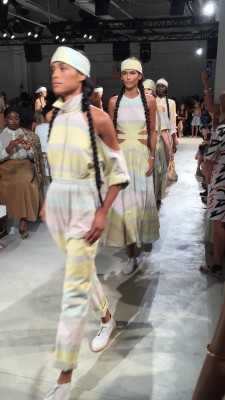New York Fashion Week, the city’s foremost fashion showcase, has been criticised as frivolous and a parody of itself, but Parsons students argue that its designers work and artistry keeps it relevant and powerful.
The bi-annual event, which kicked off Sept. 10, has showcased the world’s leading designers’ looks for the upcoming season since its initial launch in 1943.
For those outside the fashion world, and even those not currently involved, the constant praise of people working in the industry can seem irrelevant and irritating.
“I think they’re kind of close-minded people, and they’re not really interested in anything but fashion, and I think people are much more than that,” said Leila Yermekkaliyeva, a Parsons sophomore studying interior design and communication after switching her major from fashion design and management at the end of her freshman year.
Others cannot believe the hordes who assemble outside events, posing for photographers and hoping to catch glimpses of models, designers, and arriving celebrities like Kim Kardashian, Lorde and Solange Knowles.

“I think the idea of Fashion Week intrigues me a little because it’s cool, and it’s just like, something that doesn’t happen every day, but to wait outside to just see people go in, I think that’s so dumb. I feel like, who would do that?” said Parsons sophomore Jake Goldzweig, recreational clothing designer and architectural major.
Even fashion luminaries agree with the less-than-stellar direction the industry is heading into.
“It’s a ridiculous and pathetic parody of what it has been,” said Li Edelkoort, a fashion trend forecaster, in her interview with Dezeen, an architecture and design magazine.
“Fashion shows are becoming ridiculous; 12 minutes long. 45 minutes driving, 25 minutes waiting. Nobody watches them any more. The editors are just on their phones; nobody gets carried away by it,” she added.
However, certain New Schoolers are able to see through their genuine disinterest and advocate for how Fashion Week may be more than it seems.
“I think Fashion Week is pretty much based on frivolity. That being said, I think that it is validated because it is a huge part of contemporary culture,” said Alexandra Lane, senior at Lang studying history and French.
It can be a powerful platform for political discussions as well.
This year, androgynous model Rain Dove walked in both male and female shows, touching on our broadening understanding of identity.
Head designer and founder of Pyer Moss, Kerby Jean-Raymond, used his own collection to tackle the large and pressing issue of police brutality. Models came down the runway in clothing and shoes splattered with blood and the names of those who have lost their lives at the hands of police.
“For as long as I have this platform and for as long as people are going to listen to me––I’m going to take a stand on something and this is something that is important to me,” Jean-Raymond told The Huffington Post.
Jean-Raymond’s message was delivered on a particularly powerful platform, as between the two Fashion Weeks, there are roughly 230,000 people in attendance including celebrities, other designers, and an army of fashion journalists.
It’s stances like Jean-Raymond’s, in addition to the 18,000 Fashion Week staffers it takes for a designer to bring a collection to life, that elevates fashion from mere clothing into pieces of art, proponents argue. The Met recently had an exhibit on the impact of Chinese design on western fashion, hence the theme of this year’s Met Gala.
“This is the past six months of these designers lives. This is what they believe and what they feel, what they’ve seen and where they’ve traveled and visited, all on people in the form of clothes. In the end, these people are just trying to show everyone who they are and where they come from,” said Violeta Carmona, Parsons junior studying design and management.
“When you see it all happen, it’s a whole different experience and it’s amazing,” Carmona added.
Truman is the Editor-in-Chief for The New School Free Press and a senior in the Journalism + Design program at Lang. He has also contributed online content for both Interview Magazine and V Magazine, talking with musicians, directors and a variety of other artists. Born in raised in Oakland, California, he now lives in Bed Stuy with a witchy roommate who is always down to burn some candles with him.







